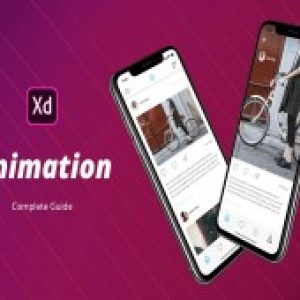UI/UX Design
UI and UX Design Courses and Certifications
In today’s digital landscape, mastering UI and UX design is crucial for creating products that resonate with users. UI (User Interface) design focuses on the visual aspects of a product—how it looks and interacts with users—while UX (User Experience) design emphasizes the overall experience users have when interacting with that product. This distinction is essential to understanding what is UI and UX design and how they contribute to a successful product.
At EdCroma, we offer a wide range of UI and UX design courses designed to equip you with the knowledge and skills necessary to excel in this dynamic field. Our courses cater to different learning preferences, ensuring you find the right UI UX training that fits your goals.
Explore Web Design to create visually appealing and user-friendly websites.
The Importance of Learning UI and UX Design
Investing in a UI and UX design course is not just about gaining skills; it’s about enhancing your career prospects and understanding user needs. Here are some key reasons to consider:
- Career Opportunities: With the growing demand for skilled user experience designers and interface designers, professionals with expertise in UI and UX can expect diverse job opportunities in various sectors. By enrolling in a course, you can position yourself for roles such as UX designer, UI designer, or freelance UI UX designer.
- User-Centric Focus: Understanding the UI and UX design meaning enables you to create products that prioritize user satisfaction. By leveraging ux and ui design software, you can enhance usability and create seamless interactions, leading to happier customers.
- Increased Earning Potential: Skilled UI UX designers often command higher salaries due to their specialized skills. Organizations recognize the value of effective design in driving product success and user retention.
Master Mobile App Development to create apps for both Android and iOS.
Showing 1–12 of 69 results

Accessibility in Angular
Up to 20% of your users may deal with a disability that makes it difficult to use applications that are not accessible. This course will teach you how to write accessible Angular code and prevent accessibility regressions by leveraging automated testing and accessibility minded developer workflows.

Accessibility: Testing and Screen Reader Use
This course will teach you different techniques to efficiently and thoroughly test your websites for accessibility, using a combination of testing tools and various assistive technologies like screen readers.

Adobe XD – Design, Prototype & Collaborate with Developers
Design & Prototype a real world Medical iPhone App using Adobe XD from Scratch. Collaborate with developers using Zeplin

Adobe Xd – UI / UX Design, Prototype And Getting A Job
Learn to Design, Prototype and Share in Adobe Xd and How to Get a Job As a UI / UX Designer

Adobe Xd Animation – Complete Guide From Icons To UI
Everything you need to know about animation in Adobe Xd.

Adobe XD CC Fundamentals
Adobe Experience Design CC can help you create interactive prototypes that you can share with clients for a complete user design experience. Learn how to create and export your designs for developers so you can maintain your design vision.

Adobe Xd Masterclass – UI / UX Design From Scratch
The most complete course to get started in UI / UX design using Adobe Xd New

Advanced Typography
Learn advanced methods for typography and fonts.

App Designing & Prototyping in Adobe XD Masterclass: Start your designing career and earn money
Probably the simplest and most effective Adobe XD Masterclass

Big Picture: Visual Design
Learn about the fundamentals of visual design such as color, typeface, and composition, and discover how developing a greater understanding of design can improve your professional skills and the products you create.

Color Theory Fundamentals
Learn the fundamentals of color theory to empower more informed decisions involving color.

Conducting UX Research
Learn how and why UX Research can help you to create intuitive and delightful experiences.
EdCroma’s Unique Approach to UI and UX Design Courses
At EdCroma, we take pride in being a comprehensive marketplace for online education, specifically focused on courses in UI UX design. Our platform offers a variety of UI and UX design classes, ensuring you find the right match for your learning style and career aspirations. Here’s what sets us apart:
- Diverse Course Selection: Our UI and UX design course offerings encompass a range of topics, including user interface design, UX design certification, and practical applications using popular tools like Adobe Experience Design and UI XI design.
- Course Comparisons: We provide detailed comparisons of different UX and UI courses, highlighting aspects like duration, curriculum, pricing, and learning format (self-paced or instructor-led). This helps you make informed decisions based on your needs and budget.
- Expert Reviews and Insights: Our team of experts reviews each course, offering insights into the quality of the content, the experience of the instructors, and potential learning outcomes. We aim to guide you toward courses that align with your career goals.
- Community Engagement: Engage with fellow learners and professionals through our platform. EdCroma fosters a vibrant community where users can share experiences, ask questions, and network within the UI UX design field.
Master Software Development to build high-performance applications.
Course Highlights
When you explore EdCroma’s UI and UX design category, you’ll find courses covering essential topics such as:
- Understanding UI and UX Design: Courses that delve into the ui and ux design meaning and explain the principles behind creating effective user interfaces and experiences.
- Practical Skills Development: Engage in hands-on learning with UI and UX design software like Figma and Sketch, allowing you to build real-world projects.
- Design Thinking Methodologies: Learn the fundamentals of design thinking, a user-centered approach to problem-solving that fosters innovation and empathy for users.
- Wireframing and Prototyping: Master the skills of wireframing and prototyping to visualize your designs and iterate based on user feedback.
- Usability Testing Techniques: Understand the methodologies for conducting usability testing to refine your designs and ensure they meet user needs.
Master Product Design to create user-centered products and solutions.
Testimonials and Success Stories
Many graduates from EdCroma’s UI and UX design courses have successfully transitioned into exciting careers, attributing their growth to the comprehensive knowledge and hands-on experience gained through our platform.
The Importance of UI/UX Design in the Digital Age
User Interface (UI) and User Experience (UX) design are critical components of digital product development. While UI focuses on the aesthetic aspects of a product, such as layout, colors, and fonts, UX centers on the overall experience a user has with that product. Both fields work hand-in-hand to create products that are not only visually appealing but also easy and enjoyable to use. Understanding UI and UX design meaning is essential, as it encompasses both the visual and functional elements that make a digital product successful. An UI and UX design course can provide the necessary skills to thrive in this evolving field.
Explore Human-Centered AI Design to create AI with user-focused interactions.
1-The Role of UI/UX in Enhancing User Satisfaction
A well-designed UI/UX can significantly impact user satisfaction. When users find a product intuitive and easy to navigate, their overall experience improves, leading to increased engagement. Satisfied users are more likely to return and recommend the product to others, creating a loyal customer base that is essential for business success. In contrast, poor design can frustrate users and drive them away, making ux and ui design software crucial for creating effective solutions.
Key Elements of User Satisfaction
- Intuitive Navigation: A clear and straightforward navigation structure allows users to find what they need quickly. This ease of use reduces frustration and enhances the overall experience, which is fundamental in any ui and ux training program.
- Responsive Design: Ensuring that a product works seamlessly across various devices and screen sizes is crucial. A responsive design adjusts the layout and functionality based on the user’s device, maintaining usability.
- Visual Appeal: A visually appealing design captures users’ attention and encourages exploration. The use of appropriate colors, typography, and imagery can enhance the overall aesthetic and create a positive first impression, integral to a successful user interface design.
Explore Ethical Hacking to identify vulnerabilities and secure systems.
2-The Business Value of UI/UX Design
Investing in UI/UX design is not just about aesthetics; it has tangible business benefits. A well-executed design can lead to higher conversion rates and improved customer retention. When users have a positive experience, they are more likely to complete desired actions, whether it’s making a purchase or signing up for a service.
How UI/UX Drives Business Success
- Increased Conversion Rates: Effective UI/UX design streamlines the user journey, minimizing barriers that might prevent users from completing actions. This can lead to higher sales and revenue, essential for any course for UI UX.
- Reduced Support Costs: A user-friendly design decreases the likelihood of user errors and misunderstandings, which in turn reduces the number of support inquiries. This can save businesses time and money.
- Enhanced Brand Loyalty: A memorable user experience fosters brand loyalty. When users associate positive experiences with a brand, they are more likely to return, leading to repeat business and long-term customer relationships.
3-Essential Skills for UI/UX Designers
User research is foundational to effective UI/UX design. Understanding the needs, preferences, and behaviors of target users helps designers create products that resonate with their audience. Courses in UI UX design can help aspiring designers develop these essential skills.
User Research Techniques
- Surveys and Questionnaires: Collecting quantitative data through surveys can help designers understand user demographics and preferences. This information guides design decisions and prioritizes user needs.
- Interviews: Conducting one-on-one interviews allows designers to gather qualitative insights into user experiences, pain points, and expectations. This depth of understanding informs design direction.
- Usability Testing: Observing users as they interact with prototypes reveals areas for improvement. Testing helps identify usability issues and provides valuable feedback for iterative design enhancements.
Learn Data Science to analyze and interpret complex data sets.
4-Wireframing and Prototyping Skills
Wireframing and prototyping are essential skills that enable designers to visualize and test their ideas before development. These skills are often covered in the best UI UX design courses, equipping students with practical knowledge.
Importance of Wireframes and Prototypes
- Blueprint for Design: Wireframes serve as blueprints that outline the structure and layout of a product. They help designers organize content and prioritize elements without getting distracted by visual design.
- Iterative Testing: Prototypes allow designers to simulate user interactions and gather feedback early in the design process. This iterative testing helps identify issues before the final product is developed, saving time and resources.
5-Visual Design Fundamentals
A solid understanding of visual design principles is crucial for creating aesthetically pleasing interfaces. Designers must consider color theory, typography, and layout to craft visually appealing and effective designs, which are key components of any UI design course.
Key Visual Design Principles
- Color Theory: Colors evoke emotions and set the tone for a product. Understanding color psychology helps designers choose palettes that align with brand identity and user expectations.
- Typography: The choice of fonts influences readability and user perception. Designers must select typefaces that complement the overall design while ensuring clarity and legibility.
- Layout and Composition: Effective layout guides users’ attention to important information. Balancing white space, images, and text creates a harmonious design that enhances usability.
Learn Machine Learning to unlock the power of data-driven predictions.
6-Career Opportunities in UI/UX Design
UI/UX designers play a pivotal role in the design process. They are responsible for creating user interfaces that are both functional and aesthetically pleasing. This role involves conducting user research, developing wireframes, and designing visual elements to enhance the overall user experience.
Responsibilities of a UI/UX Designer
- Conducting User Research: UI/UX designers gather insights about user needs and behaviors through various research methods. This information informs design decisions and improves usability.
- Creating Wireframes and Prototypes: Designers create wireframes to visualize the layout and structure of a product. Prototypes allow for testing and iteration before the final design is implemented.
- Collaborating with Developers: UI/UX designers work closely with developers to ensure that the final product aligns with design specifications. Effective communication is key to a successful collaboration.
7-User Researcher
User researchers focus on understanding user behavior and preferences through qualitative and quantitative research methods. Their insights inform design decisions and help create products that meet user needs.
Key Responsibilities of User Researchers
- Conducting Usability Tests: User researchers observe users as they interact with products to identify pain points and areas for improvement. This information is crucial for refining design.
- Analyzing Data: User researchers collect and analyze data from surveys, interviews, and usability tests. They synthesize findings to provide actionable insights for designers and stakeholders.
8-Interaction Designer
Interaction designers specialize in creating seamless user interactions. They focus on designing navigation flows, transitions, and animations that enhance the user experience.
Importance of Interaction Design
- Creating Intuitive Interfaces: Interaction designers ensure that users can easily navigate products and complete tasks. Intuitive design reduces frustration and enhances usability.
- Enhancing User Engagement: Thoughtful interaction design keeps users engaged by providing smooth transitions and feedback. This encourages users to explore and interact with the product further.
9-Visual Designer
Visual designers are responsible for crafting the aesthetics of digital products. They create visually appealing interfaces that align with brand identity and user preferences.
Role of Visual Designers
- Developing Brand Identity: Visual designers use design elements to establish and maintain a consistent brand identity across products. This fosters recognition and trust among users.
- Creating Compelling Visuals: Visual designers create graphics, icons, and imagery that enhance the user experience. Their work contributes to the overall appeal and effectiveness of a product.
Explore Artificial Intelligence for a deeper understanding of AI technologies.
Conclusion
UI/UX design is a critical aspect of modern digital product development. It impacts user satisfaction, drives business success, and creates opportunities for skilled professionals in the field. By understanding the importance of user-centered design and honing essential skills, aspiring designers can build a successful career in this dynamic industry. With the right education and experience, individuals can contribute to creating products that not only meet user needs but also delight them. Investing in UI and UX design courses, like those offered by EdCroma, is a step toward mastering these valuable skills and making a meaningful impact in the digital landscape.
